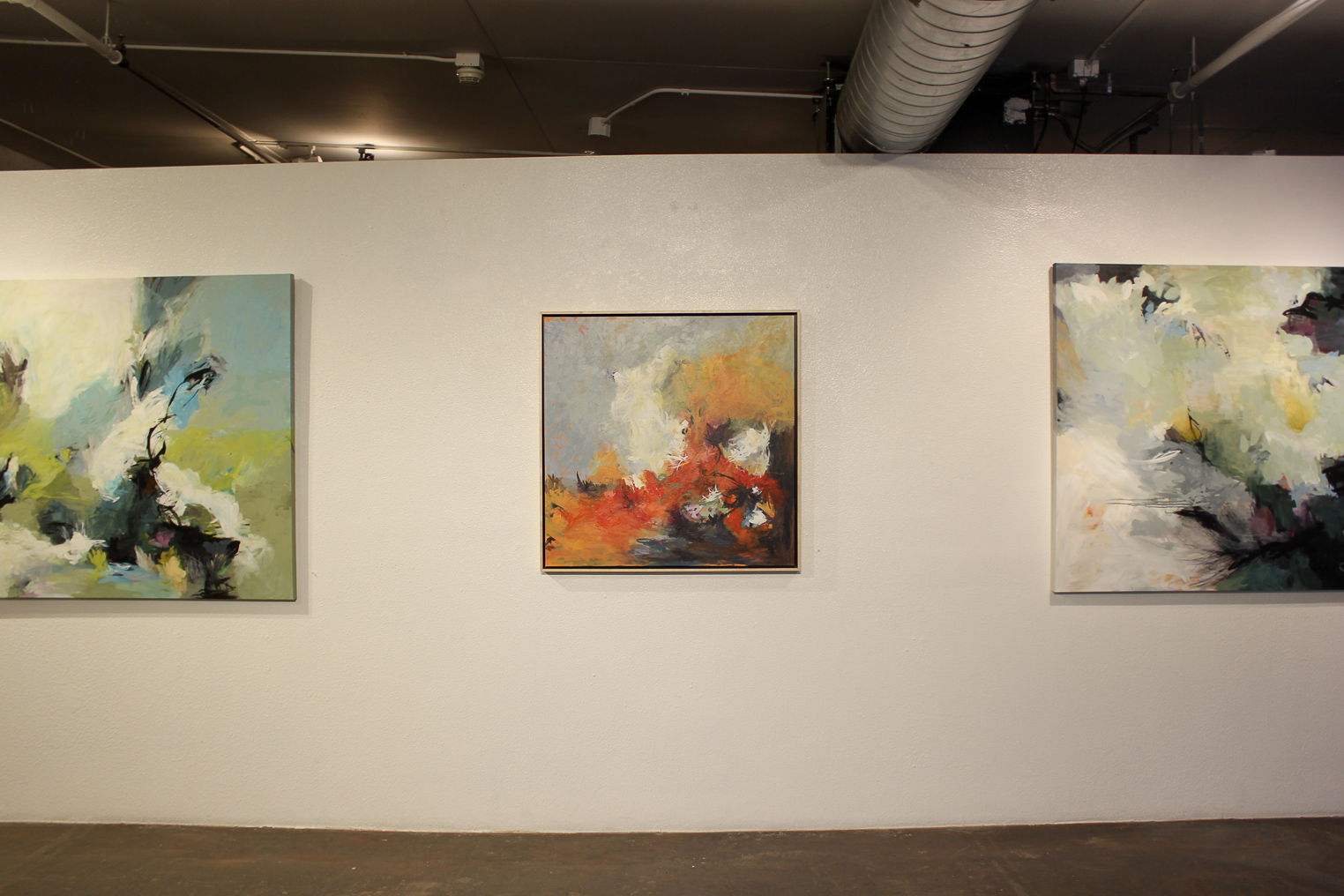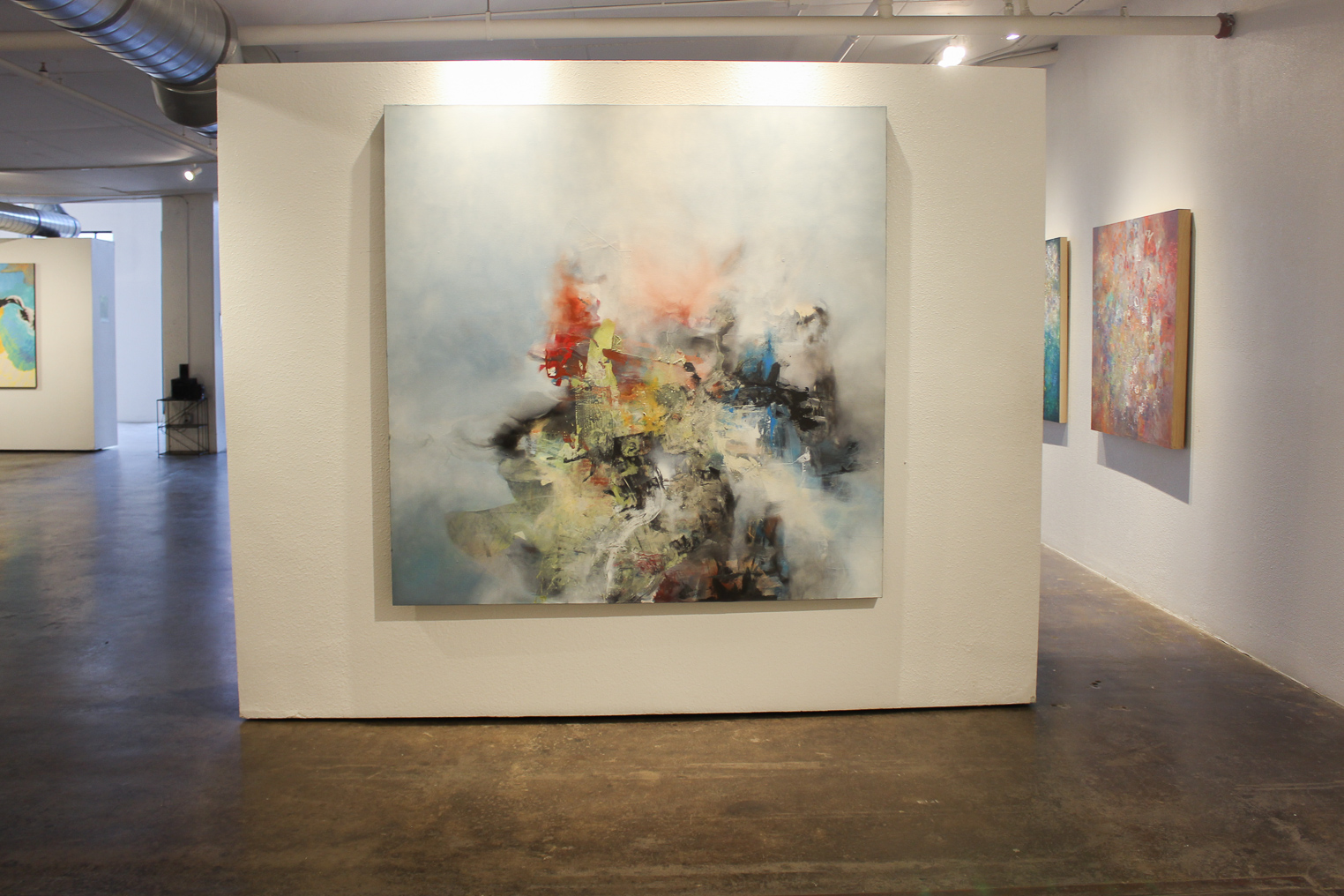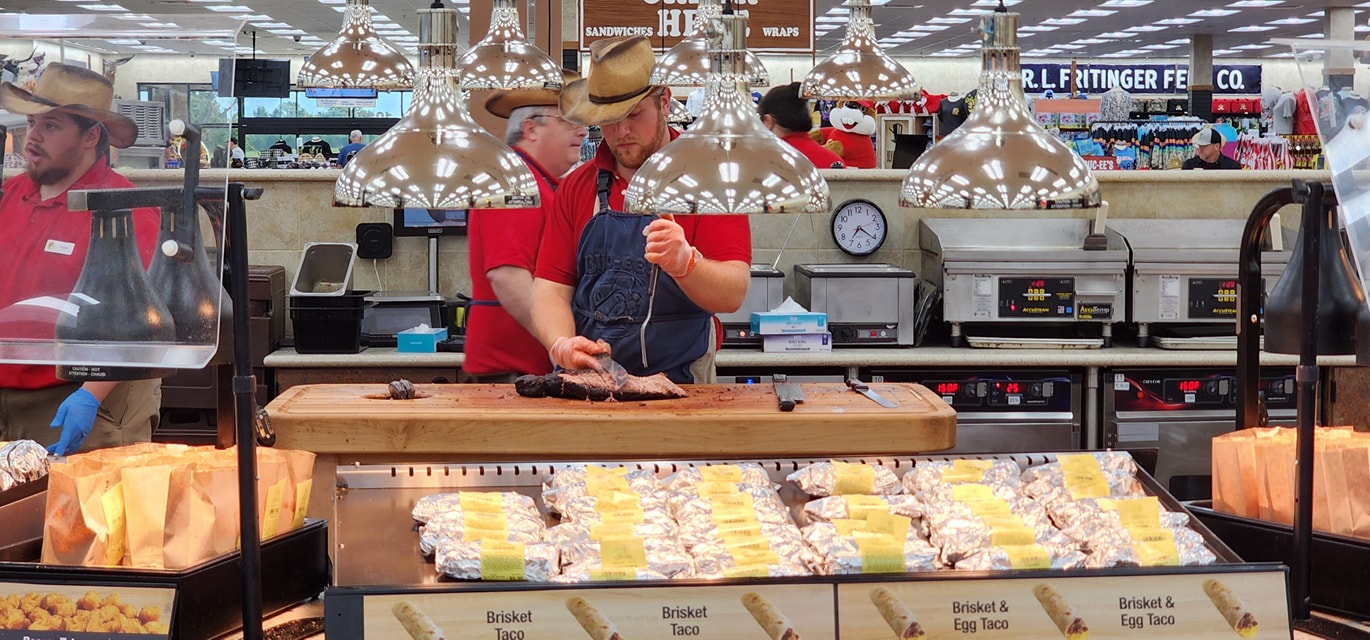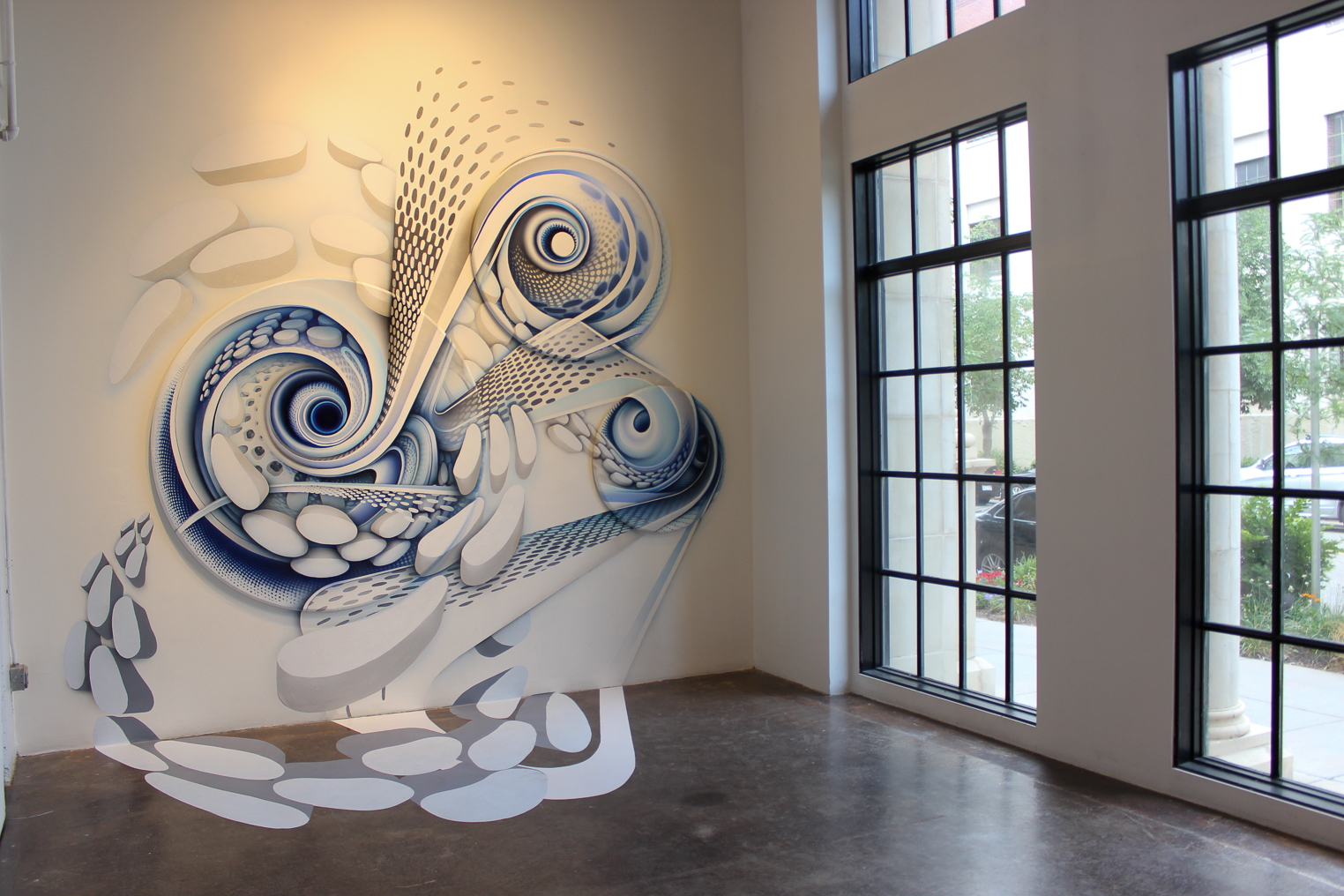Abstract art has a bad rap sometimes. It’s not uncommon to hear people talking about abstraction like they would a bad habit — “well, if that’s what floats their boat” or “that’s something my kid would do.” But the beauty — and tragedy — of abstraction in art (or any creative enterprise) is that it asks for no validation in order to come to fruition. For many abstract artists, it’s about the process or the moment of creation, rather than any climactic culmination.
So, if you fall into the skeptical category when it comes to abstraction, the new show at Walker Fine Art might rub you the wrong way. But for those of us who find at least one quality about abstraction inticing, A Conscious Surrender features six artists with a few pieces each that allows for a blissful reprieve from the increasingly hectic schedule of daily life. Shown inside Walker Fine Art, the group exhibition displays how each artist surrenders to their work and though that theme runs strong among the group, every outcome remains unique.
The six artists are Anna Charney, Ben Strawn, David Mazza, Carol Browning, Sara Pittman and Deidre Adams and their work will be on view until September 8, 2018. Read on for descriptions of each artists’ work.
Anna Charney
In just a few years, Charney has grown tremendously in her career. Since her first mural on the Colorado Ballet building on Santa Fe, she has landed other walls and sidewalks around town and yet still finds time to develop her studio work. This most recent stint in the studio found Charney working with new canvases — circular in shape rather than rectangular or square. Her contribution to A Conscious Surrender totals five pieces, though three of those are encapsulated in one composition called Orbital Oscillation — another new approach for Charney.
Orbital Oscillation — though obviously time intensive in the studio, where Charney uses graphic patterning with digital tools and then paints incredibly precise details by hand — also involved a good amount of time in the gallery to install. Using the wall and floor as another canvas, Charney added connections between the three circular pieces (34 inches, 48 inches and 68 inches), giving the impression that all of it was made at the same time. The cohesiveness of Orbital Oscillation is truly breathtaking, especially once the viewer steps to the side and sees the varying levels and surfaces. It also engulfs that corner of the gallery, both dripping and bending onto the floor in the type of illusion Charney loves to explore.
In some ways, this installation signifies where Charney is in her artistic path — bridging the worlds of studio work and street art. Whether she realizes it or not, she is able to exist in both worlds without succumbing to one over the other. By using both the decisively strict planning techniques of fine art and the on-the-spot ingenuity of street art, she creates a new genre entirely.
The other two pieces are Nervous Neutrality and Wash Mechanics and these represent a Charney we are familiar with at this point. However, there is an exactness to these new paintings that reveals how her meticulousness to each line and dot has magnified in recent months. These two pieces feel like peeking into keyholes of Charney’s talent, rather than the floor-to-ceiling window of Orbital Oscillation. But even if they aren’t as enlightening as the installation, they still showcase the organized yet expressive style that Charney is only getting better at.
Ben Strawn

Local artist Strawn grew up in a family of artists. It was in that upbringing that Strawn instinctively learned that color, line, form and light were tools for expression — a lesson he continues to learn and teach. The six paintings in A Conscious Surrender each have their own story, their own moment, but they share the same confident gestural quality that divulges Strawn’s experience in articulating his inner sentiments.
Using acrylic paints, Strawn creates energetic compositions that are like geographic maps of his emotions. The rolling peaks bordered by blue above and the colors of autumn below in “Portent” (pictured above) could be a dreamscape of a mountain range or a mirage at the end of a desert hike. There’s another layer to it, if you look long enough, where you can feel a bubbling excitement or a trapped aggression.
In that piece and in the other ones, Strawn’s loosely geographic components are not planned — they are the result of his “meanderings of lines that take the place of words” as he wrote in his artist statement. In that way, the emotive quality of his pieces are also unplanned and therefore some of his pieces feel fragmented or even slightly confusing — both of which could be accurate representations of Strawn’s mood at the time of creation. Ultimately, Strawn’s six paintings are a perfect fit for the theme of the show because his work is always a conscious surrender, where he uses the tools of color, line and form to coax out his inner thoughts and feelings.
David Mazza
Mazza is an established sculptor in Denver and has been since the early 2000s after he graduated from Rocky Mountain College of Art & Design (RMCAD). He’s had an enduring relationship with Walker Fine Art through the years and his pieces in this exhibition not only prove why Walker always kept an eye on him, they also provide a needed reprieve from all the paint.
Mazza describes the intensity with which his pieces are made, writing “even when I am not physically making sculptures, I’m still designing them in my mind. I spend hundreds of hours sweating and cutting to make the work, and I put every part of my soul into each piece.” The three pieces in A Conscious Surrender are extensions of Mazza, almost immortalized in steel. As if to make note of his mortality in relation to the fortitude of steel, however, Mazza rusted the steel on these pieces, giving them each a weathered, antique appearance.
He explains the creation of these sculptures as objects flying through space and time, where time stops when the piece is finished. There’s a beautiful image that comes to mind with this description — as if Mazza and the raw materials exist in a wormhole together, secluded from everything and yet connected to everything at the same time.
On a surface level, Mazza’s sculptures play off the other pieces of art in the gallery, reflecting the colors of the paintings and distorting their shapes and forms. Their vertical shapes and placement in a large triangle around the main part of the room give the impression of three beings, standing still in grotesque postures. They might seem creepy at first but, given enough time spent in their presence, a reassuring feeling sets in.
Carol Browning

After spending two decades as an interior designer, Browning turned her attention full time to painting. With nature as her primary muse, she produces impressionistic pieces that delicately balance romantic interpretations of wilderness with her own emotions. She writes in her artist statement, “nature’s vibrant layers of color, its ebb and flow and contrasting elements allow me to create a visual symphony on canvas.”
Browning’s three pieces in this exhibition illuminate her skill in mixing colors in just the right way so they are visually pleasing and serve a purpose. No doubt this kind of harmony between aesthetics and function comes as a result of her career in interior design, and we aren’t complaining either. Her pieces invoke introspection on the part of the viewer rather than the desire to figure out what she was thinking when she created it. And as much as any art must be internalized by the viewer to be appreciated, it is more uncommon to find something that truly acts as a mirror rather than a window.
So don’t feel shy if you want to just stare into one of these for an unusually long time. And our pro-tip? Let your eyes lose focus and then refocus on one — her choice of color and where she placed it pops out when you do this.
Sara Pittman

Originally from Alabama but now residing in South Carolina, Pittman uses the classic stream of consciousness style to produce her large paintings — allowing the process to guide the composition, rather than the other way around. “I begin moving, brushing and pouring paint until images begin to present themselves to me,” she writes. “A bridge is formed, offering me clarity and direction.”
Even though she doesn’t plan the compositions, Pittman’s paintings share similar forms or shapes and the hint of repression or reduction. Many of her pieces, and especially the one pictured above, To Feel it Again II, are like bird’s-eye views of cities or hilltops covered in fog. This style of obscuring, this fogginess, directly relates to Pittman’s main inspiration — repressed feelings and thoughts. The viewer may puzzle over what exactly they are looking at, a similar situation when dissecting emotional states.
Pittman’s four pieces in A Conscious Surrender remind the viewer that not every mode of expression can be lucid. Some emotions are too complicated or too buried or too tangled with other emotions to be clearly defined. And in that world, foggy cliffsides and blurred objects are more common than not.
Deidre Adams
Born and raised in New Mexico, Adams has lived and worked in Colorado for many years. After spending time as a graphic designer (and earning several degrees including a Bachelor of Science in Computer Information Systems and Management Science) she moved to a full-time artist in 2008. Her artistic enterprises certainly gather influence from her previous roles in life but mainly are inspired by the harsh but lovely landscapes of the American Southwest.
The four pieces Adams included in this show expose the artist’s time-consuming obsession with mark-making and layers. Spending countless hours on each piece, Adams builds up the layers with scribbles, scratches, graffiti-like marks, painted shapes and other lines. At first sight, each piece looks like a typical abstract painting, with splotches of complimentary color strewn across a canvas. But up close the magic is revealed and then continues to impress as the viewer notices more layers of marks than they could even imagine.
Because the marks are laid on top of each other relentlessly, the final pieces have the feeling of being unfinished. And also, due to the graffiti-like style of some of the markings, it gives the impression of a tagged wall or newspaper stand or bathroom stall that never gets painted over or cleaned off but always gets added to. But Adams pieces also feel like hieroglyphs or an alien language because the symbols and characters aren’t in any recognizable language. What do they mean, if anything? The viewer is left to wonder if hidden meanings litter the surfaces of these canvases, and if so, who they are written for.
—
Walker Fine Art is located at 300 West 11th Avenue and is open Tuesday through Saturday, 11 a.m. to 5 p.m. A Conscious Surrender is on view until September 8, 2018.





